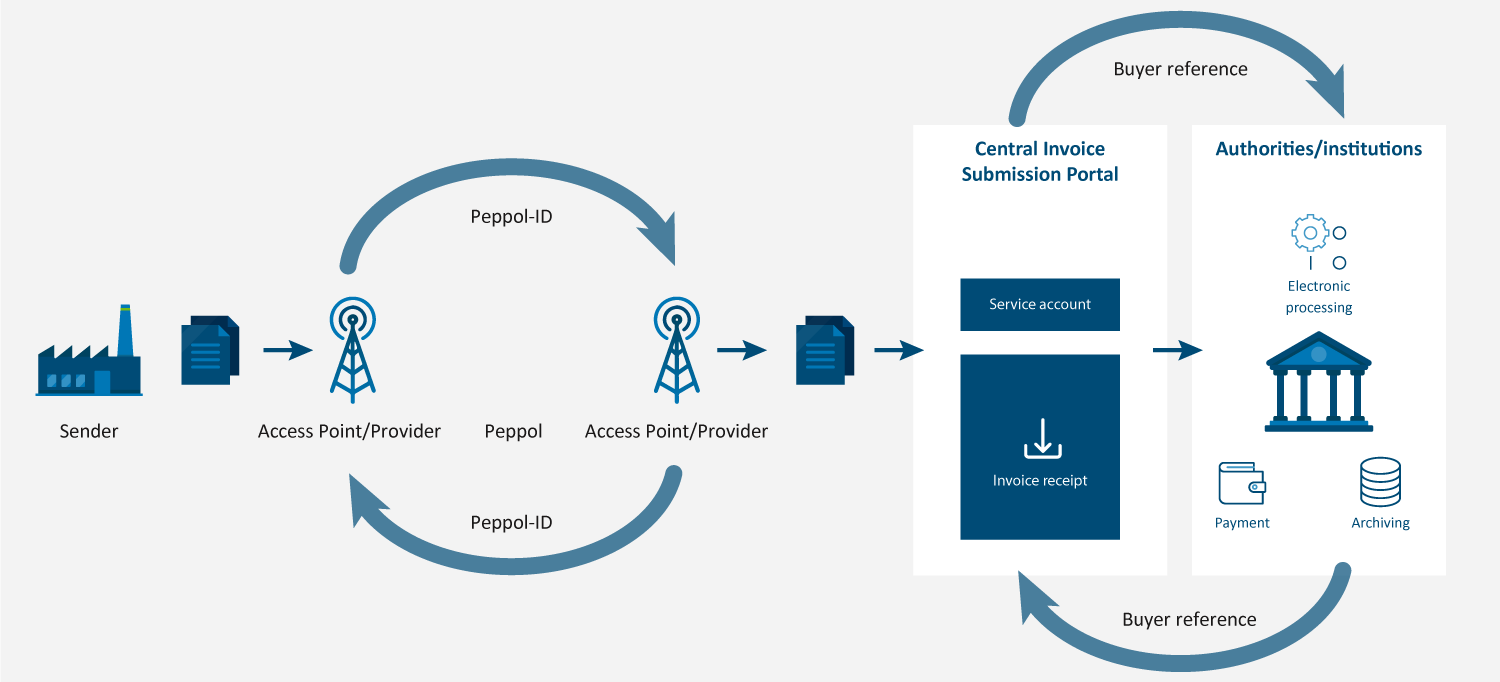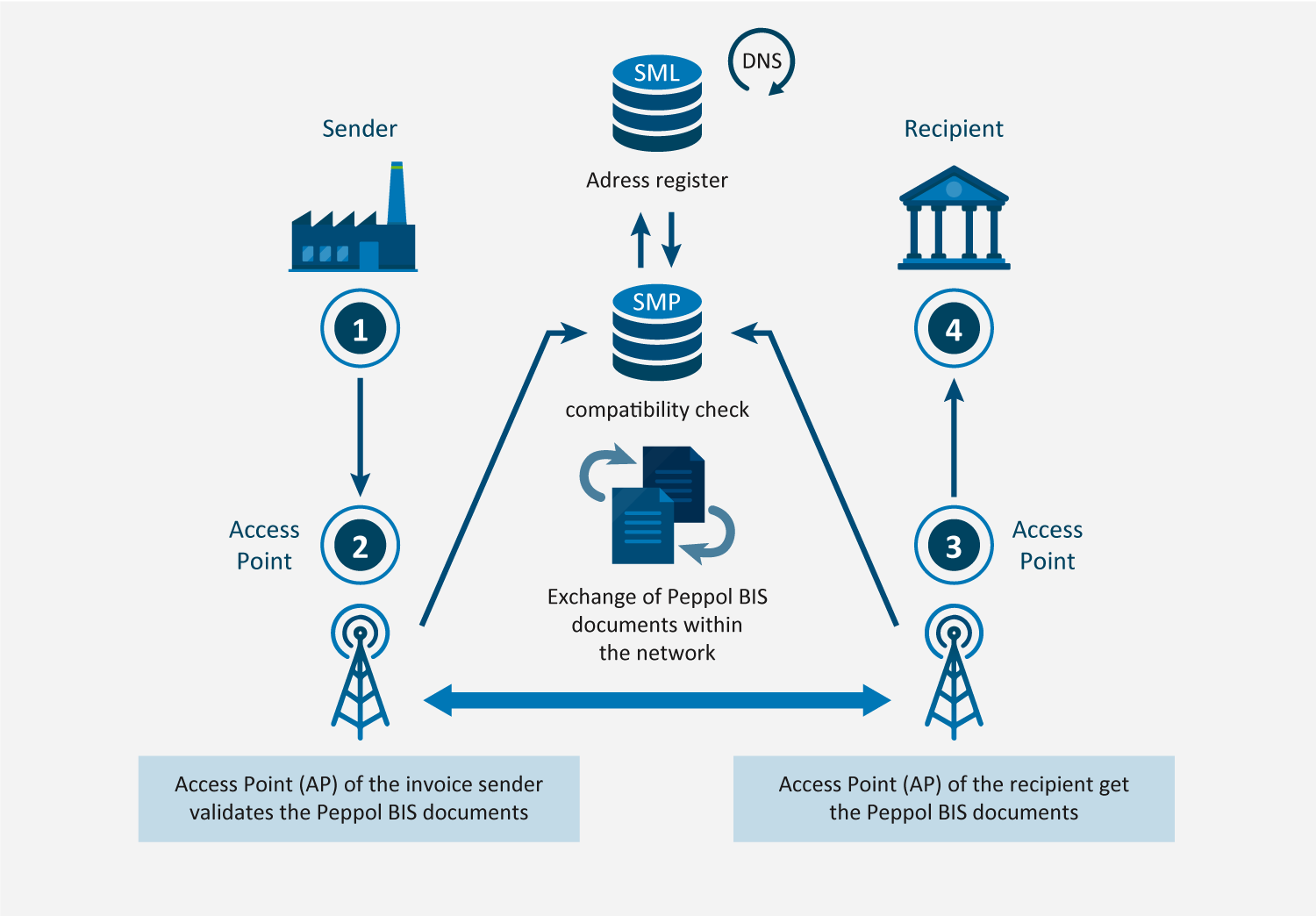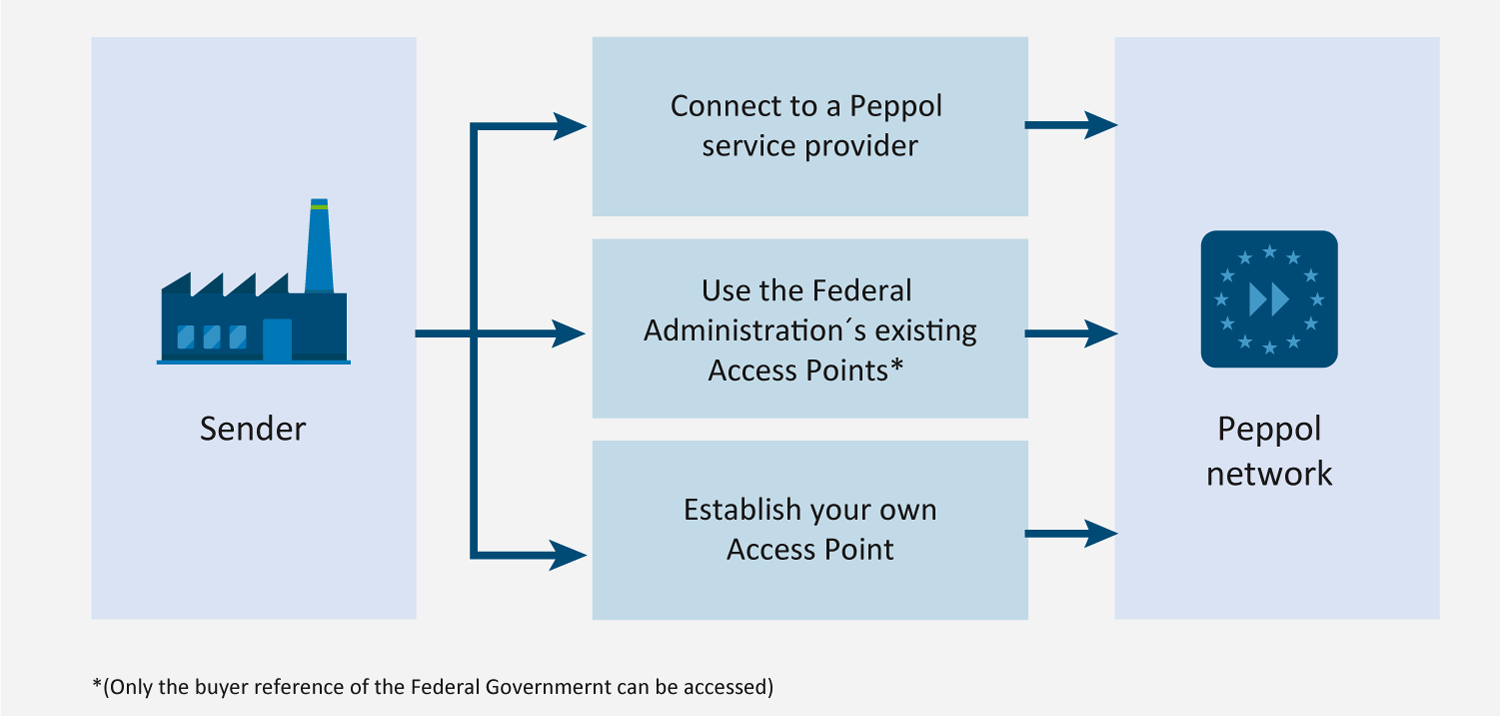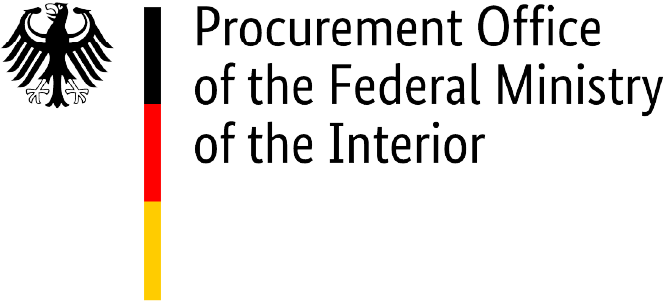Important information: Please note that the federal invoice submission portals, ZRE and OZG-RE, will be consolidated by summer 2025. Following the consolidation, only the OZG-RE will be operated as the sole federal invoice submission portal. The operation of the ZRE will be discontinued as of 31 December 2025. Suppliers will receive all relevant information and the required details for future invoicing directly from the authorities to which they submit invoices. For further details, please refer to this article.
General information
What is Peppol?
Peppol (originally Pan-European Public Procurement Online) emerged from an international project aimed at standardising public procurement and contract award procedures in the European Union and globally. Peppol is run by OpenPeppol AISBL, a Brussels-based non-profit organisation established under Belgian law.
Peppol essentially pursues the vision of creating full interoperability across different systems. This means that any business in a given country should be able to manage all procurement and contract award procedures electronically, whether it be with an administration located in the same country or abroad. For this purpose, Peppol provides a data transmission network (the Peppol eDelivery Network) and specifications for the documents to be transmitted (Peppol Business Interoperability Specifications, BIS). The main advantage offered by this organisation is the entirely electronic, seamless and automated exchange of documents. Peppol also supports the automated mass import of documents.
The invoice submission portals ZRE (for the direct federal administration) and OZG-RE (for the indirect federal administration) as well as the cooperating federal states use the Peppol network to enable suppliers to automatically submit their e-invoices.
Technically speaking, Peppol is based on what is known as the “four-corner model”.
More information about Peppol is available on the Peppol website and the KoSIT website.
What exactly is OpenPeppol?
OpenPeppol is a Brussels-based non-profit organisation established under Belgian law which aims to enable smooth, standardised and automated cross-border e-procurement. OpenPeppol is responsible for operating the Peppol network. Peppol users who wish to set up an access point of their own need to become members of the Peppol community which, in turn, gives them the opportunity to take an active role in developing Peppol. The cooperation and work on specific issues takes place in domain-specific working groups which are open to all members. OpenPeppol pursues the following aims:
- Promoting the use of electronic procurement processes by public administrations across Europe and their suppliers, using the Peppol specifications
- Advertising and using ICT products and services to support public procurement processes
- Facilitating the use of e-procurement processes in small and medium-sized enterprises (SMEs)
- Ensuring continuous growth of the Peppol network
- Guaranteeing interoperability for European public administrations
Note: Generally speaking, any organisation can become a member of Peppol; membership fees depend on the status and size of the member organisation.
What is the Peppol Coordinating Authority?
The Peppol Coordinating Authority is a body within the Peppol organisation which is responsible in particular for technical specifications within the network, for server administration and for overall contract management. The Peppol Coordinating Authority passes on specific tasks to what are known as Peppol authorities which are located all over Europe. In Germany, the KoSIT performs the tasks of the Peppol authority on behalf of the IT Planning Council. Specifically, it provides information and consultancy services to businesses and public authorities and performs tasks related to contract management in Germany. Furthermore, it provides expert and technical support and represents German interests within the overall organisation.
Data transmission via the Peppol network
How does sending and receiving documents via Peppol work?
Peppol aims to interconnect senders and recipients of electronic documents. Both the sender and recipient need an access point to access the Peppol network.
The invoice sender sends their invoice to an access point which connects to the recipient’s access point by means of the Peppol receiver ID. Once the e-invoice is received by the recipient’s access point, it is made available to the recipient. The invoice submission portals ZRE and OZG-RE are connected to the access point of the recipient (the authorities). Within the submission portals, the buyer reference (Leitweg-ID) is then used for addressing the invoices to the various authorities. Once suppliers have registered their customer’s Peppol receiver ID with the relevant submission portal and activated Peppol, they can send their e-invoices via Peppol to the invoice submission portals. The authorities connected to the system can thus retrieve e-invoices submitted via Peppol from their submission portal and process them in their systems as usual.

Illustration: Process of sending and receiving documents via Peppol
By using Peppol, invoice senders benefit from a uniform and central channel for the submission of e-invoices. You have to make sure, however, that the recipient’s invoice submission portal is also connected to Peppol. Please check with your customer whether this is the case and ask them for their Peppol receiver ID.
Please note: for organisations of the direct federal administration and organisations of the indirect federal administration as well as organisations of the (cooperating) federal states connected to the OZG-RE portal, the Peppol participant ID is composed of a prefix and the buyer reference: “0204:buyer reference”. In the case of other federal states, the Peppol participant ID and the buyer reference may differ.
What exactly is an access point?
In order to be able to receive electronic invoices, you will need a Peppol access point (in accordance with the AS4 profile). There are already off-the-shelf products (some of them open source) which only need to be installed and configured. For further specifications of the AS4 profile, please refer to the Peppol AS4-profile page.
A list of compliant products is available here: Connecting Europe Facility (CEF) Digital.
What is the Peppol participant ID and how it can it be requested?
For a sender to be able to accurately address the correct recipient, all access points and the relevant recipients need to recognise each other.
In the Peppol network, the Peppol participant ID (Peppol ID) serves to clearly identify a given participant. A distinction is made between the sender ID (invoice issuer) and the receiver ID (invoice recipient). These do not have to be specifially requested but can be assigned by the users themvelves. For Peppol sender IDs, it is recommended to use the Global Location Number (GLN) preceded by the prefix 0088 or the VAT ID plus the prefix 9930 as an individual sender ID when setting up your Peppol account.
Invoice recipients require a receiver ID. For all public institutions that are connected to the ZRE or OZG-RE invoice submission portals, the Peppol receiver ID corresponds to the buyer reference (Leitweg-ID) preceded by the prefix 0204 (e.g. 0204:991-33333TEST-33).
In addition, recipients need to be registered with a Service Metadata Publisher (SMP) server so that they can be technically found. The SMP stores further metadata concerning each participant, e.g. data regarding the types of documents which a given participant is able to receive and the access point to which they are connected. There is no need for invoice senders to register the Peppol ID with an SMP as long as they only want to send.
Examples of Peppol sender IDs (invoice senders):
-9930:VAT ID
-0088:Global Location Number
Example of a Peppol receiver ID (invoice recipient):
-0204:buyer reference
How is the Peppol participant ID connected to the buyer reference (Leitweg-ID)?
In the development of the XRechnung standard, a specific address coding schema known as the “buyer reference” (Leitweg-ID) was defined for German public-sector customers. This address coding has been registered with Peppol as an admissible schema for defining the participant identifier in the transport network. For businesses in Germany, the VAT ID schema and the Global Location Number schema are also registered with Peppol. This means that private industry customers may use their VAT ID as their Peppol participant ID to clearly identify themselves as senders or recipients in the Peppol system. For public-sector customers, the buyer reference is available as a valid identification schema.
The interconnection between a Peppol participant ID and the buyer reference or the VAT ID is established by means of different prefixes. The Peppol participant ID is composed of a four-digit numerical code which precedes the buyer reference or the VAT ID.
- Prefix 0204 + Buyer reference → 0204:Buyer Reference
- Prefix 9930 + VAT ID → 9930:VATID
- Prefix 0088 + Global Location Number → 0088:Global Location Number
To ensure standardised document exchange within the Peppol network, communication is implemented on the basis of what is known as BIS (Business Interoperability Specification). The BIS document establishes a clearly defined standard for exchanging documents within the network. For example, if an e-invoice in XRechnung format is to be sent to a recipient via Peppol, a standard business document (SBD) serves as the technical envelope in which the e-invoice (together with the SBD header) is enclosed. This SBD header must contain the receiver ID, whereas the buyer reference field (BT-10) in the enclosed invoice may only contain the recipient’s buyer reference.
What exactly is a Peppol service provider?
Any public- or private-sector customer may also connect to an existing Peppol service provider, in which case they do not need to set up and operate a Peppol access point or a Service Metadata Publisher (SMP) server of their own to receive electronic invoices from the Peppol network. Peppol service providers offer their contracting partners different interfaces, enabling them to call up incoming invoices.
An up-to-date list of existing Peppol service providers (access point and SMP) is available here: Certified Peppol Access Points (APs).
Peppol's technical solution: The four-corner model
The four-corner model describes the technical implementation of file transmission within the Peppol network. Corner 1 is the invoice sender, while corner 4 is the invoice recipient. Invoice recipients need to be registered with the Service Metadata Publisher (SMP) server. When a Peppol participant is registered, the SMP server contacts the Service Metadata Locator (SML) server. There is only one such server in the entire Peppol network: it is centrally operated by the Peppol organisation. Based on specific data, a DNS entry is created for this participant. The address of the DNS entry for the registered participant points to the SMP server where the latter was registered.
To send an invoice via Peppol, the sender (corner 1) needs to connect to an access point(corner 2). When sending an invoice, the invoice sender sends along the recipient’s participant ID. Based on this ID, the access point of corner 2 generates the correct DNS name of the invoice recipient, thus connecting to the appropriate SMP server. In Europe, there are a host of SMP servers which are used or operated by access points of corner 3. All recipients connected to the access point of corner 3 are registered with these servers. This registration includes the recipient’s unique participant ID as well as specific settings regarding the documents that can be received via Peppol. At the request of the access point of corner 2, the SMP server checks which access point of corner 3 is to be targeted and whether that access point will accept the attached document (compatibility check). Upon approval and feedback of other specific data, the access point of 2 can now exactly target the recipient’s access point of corner 3, which will then make the invoice available to the recipient (corner 4).
To ensure standardised document exchange within the Peppol network, communication is implemented on the basis of what is known as BIS (Business Interoperability Specification). The BIS document establishes a clearly defined standard for exchanging documents within the network. For example, if an e-invoice in XRechnung format is to be sent to a recipient via Peppol, a standard business document (SBD) serves as the technical envelope in which the e-invoice (together with the SBD header) is enclosed. It is not necessary to make any changes to the invoice.
It is not necessary to make any changes to the invoice even though the standard of the Peppol network is used. BIS 3.0 is compatible with XRechnung invoices.

Illustration: The four-corner model
Further information:
A list of compliant SMP implementations is available here: Links to software for Peppol implementations.
Using the Peppol network as an invoice sender
How can I as an invoice sender use the Peppol network?
In the four-corner model, there are three options for invoice senders (corner 1) to access the Peppol network via an access point (corner 2).
1. Using the Peppol web service of the federal administration (only for invoice recipients of the federal administration and cooperating federal states)
If you want to submit an invoice to a public-sector customer, you can use the federal administration’s Peppol web service free of charge in order to feed your invoice into the Peppol network. The federal administration’s access point is used for that purpose. Via this access point, you can submit your invoices to your customers (invoice recipients) in the federal administration and the (cooperating) federal states. Please note that currently only the buyer references of the federal administration and those of the federal states of Berlin (initial number 11), Brandenburg (initial number 12), Mecklenburg-Western Pomerania (initial number 13), Saxony (initial number 14) and Thuringia (initial number 16) can be reached via this access point. Implementing and integrating the interface may involve costs for external support services.
If you are interested in using the federal administration’s Peppol web service, please send an email to Peppol.Support@nortal.com.
2. Connecting to a Peppol service provider
If you do not wish to set up an access point of your own or to use the web service provided by the federal administration, you may select a Peppol service provider, who will make a Peppol access point available to you. A list of certified service providers across Europe is available here: Certified Peppol Access Points (APs).
If you send your invoices via a service provider, this will involve costs that vary, depending on the terms and conditions of the provider concerned.
3. Setting up and operating your own access point
You may also set up your own access point (from scratch or by using existing access point software) so that you can submit your own invoices or offer your access point to other customers.
If you choose to set up an access point of your own, you will have to pay the development costs involved and the membership fees. If you plan to go for this option, you should clarify beforehand to what extent your corporate IT system landscape is already prepared and how much effort will be required to implement this solution.
More information on how to set up your own access point is available here:
![]() Download document: How to set up a (Post-Award) Peppol Access Point
Download document: How to set up a (Post-Award) Peppol Access Point

Illustration: Three ways for invoice senders to the Peppol network
You should bear in mind the following before you choose either of these options:
- How many invoices do I submit in a year?
If your annual invoice volume is such that setting up an access point of your own is a worthwhile investment, it is advisable to do so. If your annual invoice volume is not sufficient to justify such an investment, we recommend that you opt for a connection via a Peppol service provider.
- How do the costs for connecting via a service provider compare to those for setting up your own Peppol access point?
Peppol service providers charge fees in line with standard systems depending on the number or volume of the invoices submitted.
How can I send test invoices via Peppol to the ZRE portal?
To check whether the invoice transmission to the ZRE portal works, it is advisable to register with the ZRE test environment and to test the invoicing process. Make sure that you never send test invoices to the live ZRE portal (production environment) or real invoices to the test environment!
In the test environment, you can create your own account. To ensure that messages transmitted by Peppol are displayed on the invoice status page of the ZRE test environment, you must add your Peppol sender ID to your user profile. You can do this via the “Manage ZRE account” button at the top right of the screen in the ZRE test environment. (Note: you must be logged into your “Natural person” account.)
Please use the following IDs for sending your test invoices to the ZRE test environment:
Peppol receiver ID: 0204:991-33333TEST-33
Buyer reference (Leitweg-ID): 991-33333TEST-33
If you are already in contact with an invoice recipient and wish to run a test with them, you may also use their buyer reference.
Once transmission via Peppol works in the ZRE test environment, you may send real invoices to the live ZRE portal (production environment). Please make sure that you also add your Peppol sender ID to your user profile in the ZRE production environment. When sending invoices via the ZRE production environment, please note the following:
Peppol receiver ID = 0204: Buyer reference of your customer
Your customer will provide you with the buyer reference (Leitweg-ID).
How can I send test invoices via Peppol to the OZG-RE portal?
To check whether the invoice transmission to the OZG-RE portal works, it is advisable to register with the OZG-RE test environment and to test the invoicing process. Make sure that you never send test invoices to the live OZG-RE portal (production environment) or real invoices to the test environment!
Please use the following IDs for sending your test invoices to the OZG-RE test environment:
- Peppol receiver ID: 0204:99661-WEBSERVICEOZG-28
- Buyer reference (Leitweg-ID): 99661-WEBSERVICEOZG-28
If you are already in contact with an invoice recipient and wish to run a test with them, you may also use their buyer reference.
Once the transmission via Peppol works in the OZG-RE test environment, you may send real invoices to the live OZG-RE portal (production environment). When sending invoices via the OZG-RE production environment, please note the following:
- Peppol receiver ID = 0204:buyer reference of your customer
- Your customer will provide you with the buyer reference (Leitweg-ID).
Is there a file size limit for e-invoices transmitted via Peppol?
Currently, in order to ensure transmission, e-invoices should not exceed 100 MB.
What should invoice issuers outside Germany bear in mind when transmitting e‑invoices via the Peppol web service?
Invoice issuers from inside and outside Germany may use Peppol to transmit e-invoices to the federal invoice submission portals.
However, please note the following:
- In order to send e-invoices via Peppol, invoice issuers need a Peppol sender ID. While you are free to choose your own Peppol sender ID, its structure must comply with a schema defined by Peppol; for invoice issuers in Germany, the sender ID is normally based on their VAT ID number.
- In order to submit an electronic invoice via Peppol from outside Germany to an organisation in the German federal administration, the schema of the sender ID must be included in an approved code list defined by Peppol.
- Foreign VAT IDs are often based on a schema which is not suitable for transmitting e-invoices via Peppol and are thus not approved. Code lists are available here: https://docs.Peppol.eu/edelivery/codelists/
- Invoice issuers from outside Germany choose from the schemas on this list to create their own Peppol sender ID.
More information on Peppol is available here on the website of the KoSIT.
How can Peppol be used to send electronic invoices to recipients outside Germany?
When using Peppol to send electronic invoices to recipients outside Germany, you will need to either appoint a service provider or set up your own access point. The federal administration’s Peppol web service can only be used to reach institutions linked to the ZRE or OZG-RE.

